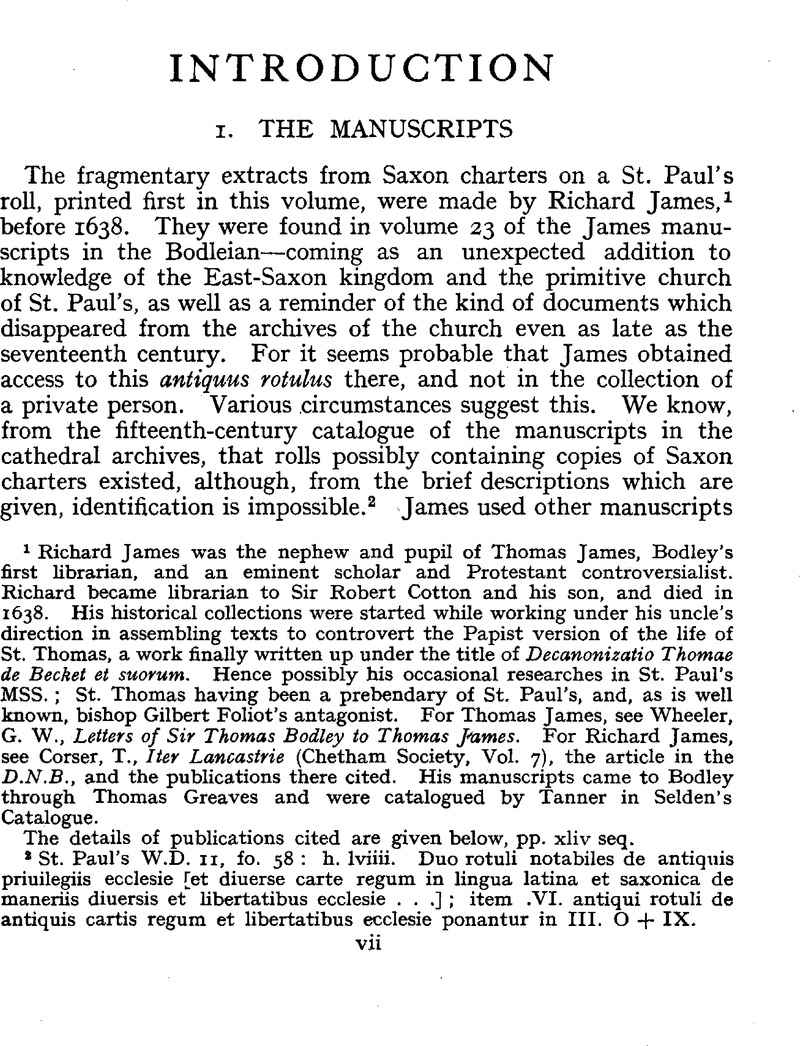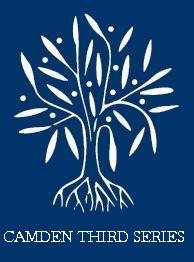No CrossRef data available.
Article contents
1. The Manuscripts
Published online by Cambridge University Press: 24 December 2009
Abstract

- Type
- Introduction
- Information
- Camden Third Series , Volume 58: Early Charters of the Cathedral Church of St. Paul, London , July 1939 , pp. vii - xvi
- Copyright
- Copyright © Royal Historical Society 1939
References
page vii note 1 Richard James was the nephew and pupil of Thomas James, Bodley's first librarian, and an eminent scholar and Protestant controversialist. Richard became librarian to Sir Robert Cotton and his son, and died in 1638. His historical collections were started while working under his uncle's direction in assembling texts to controvert the Papist version of the life of St. Thomas, a work finally written up under the title of Decanonizatio Thomae de Becket et suorum. Hence possibly his occasional researches in St. Paul's MSS.; St. Thomas having been a prebendary of St. Paul's, and, as is well known, bishop Gilbert Foliot's antagonist. For Thomas James, see Wheeler, G. W., Letters of Sir Thomas Bodley to Thomas JamesGoogle Scholar. For Richard James, see Corser, T., Iter Lancastrie (Chetham Society, Vol. 7)Google Scholar, the article in the D.N.B., and the publications there cited. His manuscripts came to Bodley through Thomas Greaves and were catalogued by Tanner in Selden's Catalogue.
The details of publications cited are given below, pp. xliv seq.
page vii note 2 St. Paul's W.D. 11, fo. 58: h. lviiii. Duo rotuli notabiles de antiquis priuilegiis ecclesie [et diuerse carte regum in lingua latina et saxonica de maneriis diuersis et libertatibus ecclesie …]; item VI. antiqui rotuli de antiquis cartis regum et libertatibus ecclesie ponantur in III. O + IX.
page viii note 1 See note below, and MSS. James, : 7, pp. 120–3; 25, pp. 155Google Scholar seq.
page viii note 2 These are not analysed in Selden's Catalogue, probably because of their hasty and fragmentary character. They include in their order these items: (i) Notes from an inventory of books; constitutions; articles of enquiry; all found in St. Paul's MS., W.D. 9. (ii) Extracts from a thirteenth-century “small codex” of St. Paul's, not otherwise known, (iii) Extracts quoted from Josselin's “Liber Excerptorum,” including texts from the Eynsham cartulary, the de Vere register, and the Liber Eliensis. (iv) Notes possibly from a lost inventory of the books of the cathedral library, or else from the several manuscript books referred to. (v) Extracts from the “antiquus rotulus ecclesie S. Pauli.” (vi) Extracts from a “Domesday” “register of St. Paul,” i.e. St. Paul's MS., W.D.3 (Liber K). A space following the copies of the ancient charters contains a copy of an indulgenced prayer copied from a notebook of Selden's, probably on some later occasion. There is no reason to believe that the copies from the roll come to us via Josselin's extracts, although Josselin, Archbishop Parker's secretary, was a more notable student of early charters than James.
page viii note 3 B.M., MS. Lansdowne 364, fo. 145v). Priuilegia et terrae concessae: Manerium de Fulanham, Manerium de Tyrranham, Gillingas, Gillanduna, Haemela, Heddaham, Willaham, (bis) Mealduna, Scopinland, Horscada, Bersted (?), Berlingis, Bacanuella (?). On the fly leaf the name J. Franklin and the date 1684 appear, but the notes themselves betray their date of composition. The author seems to have been connected with the cathedral, and may therefore have been in touch with James. Cf. the entirely different list of the lands of the church of St. Paul, c. 1000, published by Liebermann, : in Archiv für das Studium der neueren Sprachen, CIV, pp. 17Google Scholar seq. This list comes from a Corpus Christi MS. said to be written at St. Paul's in the early twelfth century: C.C.C. MSS. 383. (Leges Anglo-Saxonicum.)
page viii note 4 This suggestion is made on the likely supposition that both James and the unknown investigator would make omissions.
page viii note 5 E.g., neither George Hickes nor Wanley knew anything of it. See Hickes, : Thesaurus Linguarum Septentrionalium, vol. iiGoogle Scholar. But Wanley, as he states, had not worked at the St. Paul's archives. Dr. Hutton did not see the roll. Of the slighter notes of the antiquaries made from St. Paul's MSS. I have looked through some, but by no means all. A slight modification in the statement written above should perhaps be made in favour of Henry Wharton, who makes a brief and very inaccurate reference to one of the James charters (No. 4) in his De episcopis et decanis Londinensibus. Hearne's edition of Leland's Collectanea, (1715) contains the latter's notes on the St. Paul's manuscripts, but they are very slight and only the well-known Saxon charters of St. Paul's first printed by Dugdale are alluded to; op. cit., I. ii, pp. 353–7.
page ix note 1 Bodley, MS. James 25, pp. 155 seq.
page ix note 2 This suggests that the inscription “Liber A. siue pilosus” on the first folio was not yet written. Cf. below, pp. xl–xli.
page ix note 3 Nos. 1, 4, 9, 10, 42, 50, 59, 76, 176, 177, 267, in this volume.
page x note 1 A. hig; J. hit. A. nelle; J. nille. A. underson; J. underfon. A. landara; J. landare. On the abbreviation beres for biscopes he notes et in alia registro b'es. He notes too the similarity of the writ to one issued by William I. Cf. his notes on the writ of Ethelred II (below, James charters, No. 3).
page x note 2 Maxwell-Lyte, : Report, pp. 60, 71.Google Scholar
page xi note 1 A list of the cartularies has been twice compiled from the descriptions in the catalogue of Dean Lyseux, St. Paul's MS., W.D. 11: see Hale, W.: Domesday of St. Paul's, pp. xvi–xviiGoogle Scholar; Holtzmann, W.: Papsturkunden in England, I, 173–9Google Scholar. The indexed tabulœ contentarum which follow the descriptions are full enough to indicate generally the contents of the volume. Liber E (plicatus) seems to have been the fullest cartulary. For the MSS. extant at the end of the seventeenth century (including the complete Liber B, Liber F, Liber G) see the Hutton Collections: B.M., MS. Harl. 6956.
page xi note 2 Liber A measures 15″ x 10½″, the neighbouring Liber B (two leaves of which are found in Bodley, MS. Rawlinson B. 372), 14″ x 9¾″.
page xi note 3 B.M., MS. Harl. 4080 (the Almoner's register).
page xi note 4 Bodley, Rawl. B. 372, and Liber K have both been edited by Archdeacon Hale: op. cit. Rawl. B. 372, the fragment of Liber B still extant, contains the Capitula of the whole volume, and using these in conjunction with the catalogue of Dean Lyseux, the texts printed by Dugdale, and the notes made by Dr. Hutton at the end of the seventeenth century (Harl., 6956, p. 160) it is possible to know the character of the register. Only the first of the eleven capitula dealt with the inquisition of 1181 into manorial property; the other shorter ones, with churches and London properties and charters touching the ‘liberties’ of St. Paul's. Dr. Hutton also made extensive notes from the now lost Liber F., apparently a register of early statutes described in W.D.11 as the Register of Diceto, Ingoldisthorpe, Roger Leygham Henry and Robert the Deans.
page xii note 1 St. Paul's MS., W.D. 11.
page xii note 2 A large portion of Liber L (W.D. 4) and a full list of contents has been printed by Maxwell-Lyte: H.M.C. 9th Report, Part i, Appx.; and other considerable parts by Hale: op. cit.; Simpson, W. S.: Registrum StatutorumGoogle Scholar. A facsimile of fos. 47–50b is given by Price, J. E.: The Guildhall (1886)Google Scholar, and a transcript by Davis, , H. W. C. in Essays presented to T. F. ToutGoogle Scholar. The manuscript contains, besides the tables of contents: (1) A mid-twelfth century cartulary (fos. 1–56). (2) The Statutes of Diceto and Cornhill, in thirteenth-century texts. (3) Material supplementary to part (1), much of it based on Liber B, all directly related to the business organization of the chapter; written at St. Paul's in the later thirteenth century.
page xii note 3 Simpson, : op. cit., pp. 132–4Google Scholar. Cf. ibid., pp. 73, 77.
page xii note 4 Below, p. xxxvii.
page xiii note 1 It has been suggested that parts of Liber A may have been written under the direction of Alexander of Swerford, the treasurer of StPaul, 's: Red Book of the Exchequer (ed. Hall, H., Rolls Series), I. xlviiGoogle Scholar. This seems unlikely. After the ordinance of 1162 touching the office of treasurer, the actual duties of the office must soon have been performed by the sacrist, usually a minor canon (see Simpson, : op. cit., p. 21Google Scholar). The office thenceforward was not of necessity resident. It is, however, possible that the work was done through the camera of the church. Certainly the tables of contents, the earliest written in the late thirteenth century, were compiled for the benefit of this department. For the camera see below, p. xxxvii, and the scriptorium, p. xxxviii.Google Scholar
page xv note 1 A Liber C is described in St. Paul's MS., W.D. 11 as the smaller register of Diceto with a white cover. This register is now lost. In the seventeenth century MS. W.D. 2 was described by Dr. Hutton as Liber C. This register, it seems, was bound in the ancient cover of Diceto's smaller register. The binding is of white skin folding to fasten with a button.


